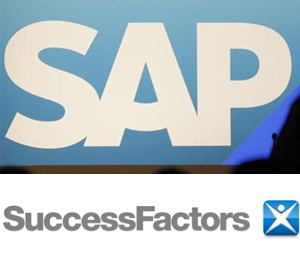5. SAP and SuccessFactors have complementary customer bases, allowing for cross-sell
There is reportedly little overlap between SuccessFactors’ 15 million users (at 3,500 customer companies), and SAP’s huge base of users. This allows for a significant opportunity for SAP to cross-sell into SuccessFactor’s customer base. The San Mateo, Calif.-based SuccessFactors operates in 170 countries. CEO McDermott said SuccessFactors’ added sales — boosted by SAP’s distribution channels — could help SAP beat its 2015 revenues target of 20 billion euros by as much as 1 billion.
6. Seamless integration with SAP’s back-end could make SuccessFactors more compelling
Granted, this point may be true only for SAP’s wealthiest enterprise customers that can afford SAP’s on-premise offerings. But because SAP is the leading on-premise software provider, it’s had a lot of experience learning how to integrate cloud software offerings with on-premise software. For example, say you’re using a cloud application, and you’re looking at a customer profile in that app. If want to look up that customer’s credit history within SAP’s back-end software, you can do that without a hiccup. SAP will make that sort of integration for SuccessFactors seamless.
This contrasts with the difficulty of integration of other software not owned by SAP, like Salesforce.com. Indeed, integrating Salesforce.com requires bringing in a third-party solution just to glue things together, SAP’s Poonen said. “We’ll have a clear leg up,” said Poonen, referring to anytime a cloud software wants to integrate with SAP’s core HR, compensation systems, or financial software.
To be sure, there a lot of questions that still need to be addressed regarding the integration of SuccessFactors overall, not to mention other challenges integrating the social business assets of SuccessFactors, which includes CubeTree, a collaborative software that includes things like wikis, blogs, polls and filesharing. But SAP’s Poonen argues that SAP’s organic growth — which stands in contrast to Oracle’s cobbling together of many pieces of software — has made for a user experience that is more elegant.
7. SuccessFactors is free from the chains of SAP’s enterprise software sale legacy. This could herald a bigger break at SAP in the future.
SAP says it is going to let SuccessFactors run independently, with a software-as-a-service (SaaS) subscription model. Could this be the first move by SAP to free itself eventually from reliance on its costly on-premise business model? To be sure, SAP has too much at stake to turn its back on its existing model. But SAP needs to do both, and it’s making the right noises regarding the cloud.
The purchase of SuccessFactors is being made by SAP America, a different entity than the German parent company SAP AG, which some observers hope could suggest a move to create a separate cloud division that lets SAP distances itself from an on-premise business model still further.
At the least, SAP’s Poonen confirmed in our interview that the plan is to let SuccessFactors operate unfettered by SAP’s on-premise sales strategy: “The cloud business runs on a different type of DNA, a different clock cycle,” he told me. “The selling motions are different. SuccessFactors will need access to our customer base, but they will not be bound by our approach. Their development team needs to innovate monthly and quarterly.”
8. This is a huge cloud play, stealing the initiative over the other full-stack providers
Among the companies are considered full-stack software providers — SAP, IBM and Oracle — this is appears to be one of the biggest moves yet from any of them to embrace the cloud. Oracle acquired CRM company RightNow for $1.3 billion in October, which was seen as an acceleration of the cloud wars, but many see RightNow as an uninspiring company, which Oracle is largely buying for its cashflow.
There’s no doubt that SuccessFactors is a huge play in cloud, at a key time. The cloud is nascent, with major cloud companies like SalesForce and Amazon only now hitting $2 billion and $1 billion annual cloud revenues respectively. The global market for cloud services is expected to explode, to $148.8 billion in 2014, from just $68.3 billion in 2010, according to researcher Gartner Inc.
Yet we’re still early, as there are few other big cloud players besides Salesforce and Amazon. According to Poonen, SuccessFactors is one of the next biggest (it has about $300 million in revenue). So it’s a nice gem indeed for SAP to slot into its cloud product. SAP’s cloud platform is called Business ByDesign, and it refers to the software SAP plans to let people access over the Internet. It has 700 customers, and growing.
9. It’s a nice complement to SAP’s analytics and mobile strategies
SAP has kicked off two key initiatives lately, namely the building of an in-memory database computing technology (called HANA), to speed up analytics within applications, and a move to allow software to work wirelessly on any device. These two initiatives were boosted by SAP’s purchase of business intelligence giant Business Objects for $6.78 billion in 2007, which SAP now powers with HANA, and SAP’s acquisition of Sybase last year for $5.8 billion, which lets SAP go mobile with its software products. SAP will also have SuccessFactors run on HANA, to turbocharge its performance, according to Poonen.
VentureBeat's mission is to be a digital town square for technical decision-makers to gain knowledge about transformative enterprise technology and transact. Learn More

